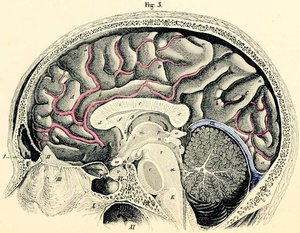Sylvian Aqueduct Syndrome Diagnosis

Upon consultation with the prescribing doctor, he made a diagnosis of Sylvian Aqueduct Syndrome (SLAS). At the time, I felt my condition was consistent with vestibular neuronitis (inflammation of the inner-ear nerve) and endeavoured to bring this to his attention, but he remained adamant that I had SLAS. Being a world renowned doctor in dizziness, I decided to have faith in his decision.
He said that it was a rare congenital condition that only about one in a hundred doctors could treat. He said that in order to treat this condition it would be necessary to change the constitution of my organic makeup with the use of drugs.
He called the prescriptions a “drug cocktail” and added that he was going to take “a radical approach” to the treatment. He prescribed 5 different drugs including 3 kinds of benzodiazepines. These were Contol (Chlordiazepoxide), Rivotril (Clonazepam), Grandaxin (Tofisopam), a tricyclic antidepressant called Tofranil (Imipramine) and a type of anti-inflammatory called Ketas (Ibudilast).
However, I later received expert verifications, including a report from Dr. Hutchinson (Neurologist), stating that I did not in fact have SLAS, and even if I did, the drugs prescribed to me were completely inappropriate for this.
This fact was repeatedly clarified by several leading neurologists from both New Zealand and Japan including those from Japan’s leading hospitals. They also said that SLAS is an old concept which is no longer recognized in modern medicine practice.
Certainly I showed none of the signs associated with SLAS which would generally include: vertical nystagmus (eye movements), convergence-retraction eye movements, paralysis of convergence, disjunctive eye position, skew deviation, upper lid retraction, lid flutter, papilledema (swelling of optic nerves), extraocular palsies etc.
The fact I showed none of the signs of SLAS can be easily verified by comparing the symptoms at the time of my vertigo attack (May 11, 2000) recorded in article 1.4.3 of Addiction Report One with the description of SLAS in the Dictionary of Medical Syndromes (includes Japanese translation).
NB: Article 3.4 of Addiction Report Three clarifies the consistency between the content of Addiction Report One and the evidence (Patient files etc).
SLAS is a rare condition caused by hydrocephalus (abnormal accumulation of cerebrospinal fluid (CSF) in the ventricles, or cavities, of the brain), neoplasia (tumors), vascular lesions, infections, trauma, and malformations etc. These can cause compression of the sylvian aqueduct and the prognosis is said to be poor (meaning recovery is difficult).
However, in my case, I was able to make a recovery after stopping the drugs (which ultimately only made me suffer a needless dependency). My recovery was so remarkable that I went from someone who was barely able to walk to someone who could squat 180kgs in the gym and do full day hikes in the mountains (See My Recovery).
Top of Page
As explained above, and as shown in the Expert Verifications, the drugs prescribed to me were completely unsuited to both the condition I actually had (Vestibular Neuronitis) and the condition I was incorrectly diagnosed as having (Sylvian Aqueduct Syndrome).
Also, as indicated in The Ashton Manual, these drugs shouldn’t be prescribed for any more than 2-4 weeks, and it is recommended that only one type of benzodiazepine be prescribed at one time because they don’t mix well (see article 1.1.2 of Addiction Report Three).
Yet after about 7 months of prescriptions (after I had become dependent) the prescribing doctor told me “if you stop taking the drugs (the so-called "drug cocktail") and return to New Zealand, you will not be able to make a recovery” (see article 4.11 of statement one).
Despite his continued advocating of his dangerous "drug cocktail", I returned to New Zealand and stopped the drugs, and after doing so, made the recovery he said was impossible.
Top of Page

The primary language of this website is English. Japanese appears as translations only (except for some original court documents).
These translations have been done by many different translators including me. Therefore, there are differences in quality and styles.
Please understand that I am not native Japanese and subsequently there are parts that may sound unnatural in Japanese.

Some parts of this website still have not been translated into Japanese. If anyone (native Japanese) would like to help on a volunteer basis, please contact mentioning the part you would like to translate. Thank you.
“The benzodiazepines are probably the most addictive drugs ever created and the vast army of enthusiastic doctors who prescribed these drugs by the tonne have created the world's largest drug addiction problem.”

The Drugs Myth, 1992






